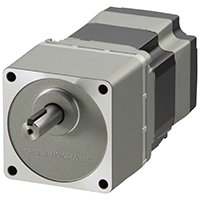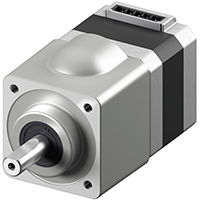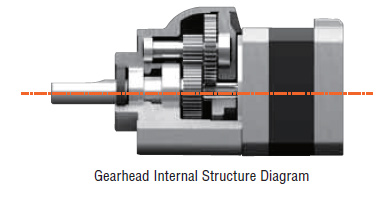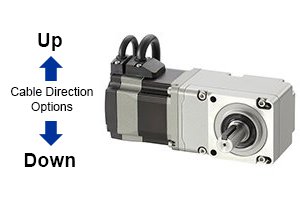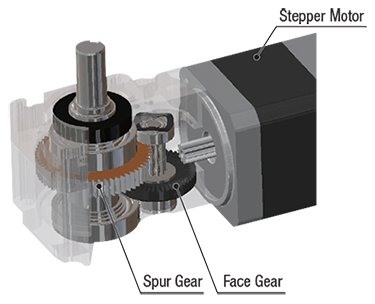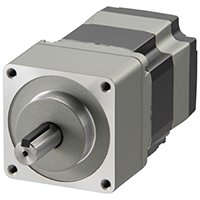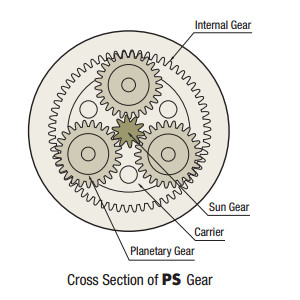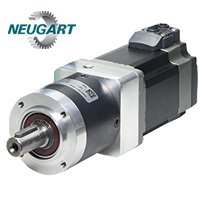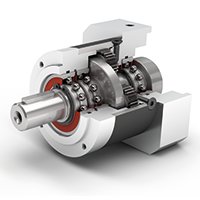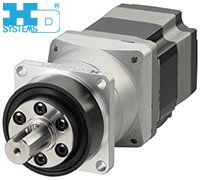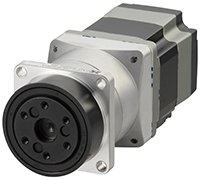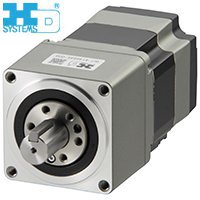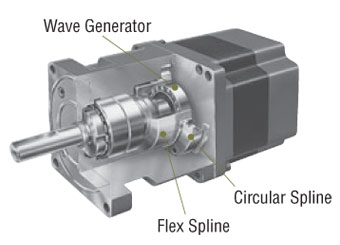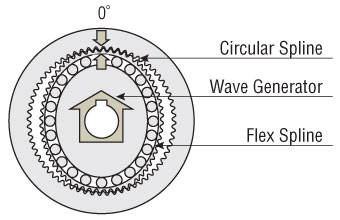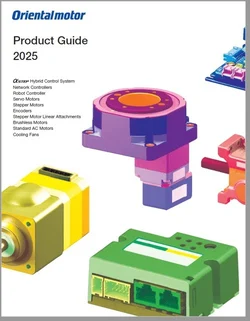Selecting a gearhead for a stepper motor is like picking out the right shoes for the occasion. Sure, you can wear Air Jordans on a football field, but they're not better than a pair of regular cleats. Similarly, you can use a harmonic gearhead to drive a unidirectional conveyor, but you may be overpaying for its zero-backlash capability when you don't have to. Picking the right gearhead can ensure the best balance between performance and budget.
In this article, I'll cover the types of gearheads offered for stepper motors and how to select one.
Topics covered:
- Why Use a Gearhead?
- Stepper Motor Sizing Example - Ball Screw Drive
- About the αSTEP AZ Series
- Types of Gearheads Offered for Stepper Motors
- Summary
First, we'll dive into the reasons why gearheads are used.
|
 |
For other advantages of geared motors, please read this article.
|
Permissible Torque TG = TM × i × η
|
T.G. = Gearhead Permissible Torque T M = Motor torque i = Gearhead reduction ratio η = Gearhead transmission efficiency |
The gearhead output shaft speed is the motor output shaft speed divided by the gear ratio.
![]()
Typically, the combined specifications for the gearmotor are already listed by the manufacturer, so all you have to do is verify the numbers. However, if you purchased a motor and a gearhead from different manufacturers, then you'll have to do some calculations to determine the final output.
Determining the proper gear ratio requires knowing the torque, load inertia, and speed requirements for the specific application, so motor sizing calculations must be done first.
After performing motor sizing calculations, select a motor and a gearhead (gear motor) that satisfy the required torque, total load inertia, and speed (RPM). Remember to add a safety factor.
|
Stepper Motor Sizing Example - Ball Screw Drive
There are many formulas to calculate the required torque. The trick is knowing which one to apply. For a stepper motor driving a ball screw, here's the formula used to calculate the required load torque. First, figure out the "F" force (2), then plug it into the TL (load torque) formula (1).
Now, add up all load inertia values of objects driven by the motor to calculate the acceleration torque. Acceleration torque is used only during the acceleration or deceleration portions of the motion profile. When the acceleration/deceleration time is shorter, this value can be larger than the load torque. Make sure you add the acceleration torque to the load torque for the total required torque. A load inertia and a rotor inertia value are necessary for calculating acceleration torque.
 Once completed, determine your total required torque by adding your required acceleration torque to your required load torque and then adding an adequate safety factor. Make sure the total required torque is under the permissible torque specification of the motor + gearhead. Also, confirm if the required RPM is within the specifications of the motor + gearhead.
|
| FYI | When to use planetary or harmonic gearheads? |
| For high precision motion control applications where the motor is operating in both CW and CCW directions, gear backlash can cause missed steps. If backlash is a problem for the application, make sure to choose either a harmonic gearhead (no backlash) or a planetary gearhead (very low backlash). |
About the αSTEP AZ Series
The αSTEP (AlphaSTEP) AZ Series is part of the αSTEP AZ Series product family that offers the most gearhead options. The AZ Series is a closed-loop stepper motor and a universal driver system that combines the simplicity of open-loop stepper motors with the intelligence of servo systems. The AZ Series offers unparalleled accuracy, reliability, and ease of use. This innovative technology utilizes a self-correcting hybrid control algorithm, low-loss laminations, and a battery-free mechanical absolute encoder, eliminating the need for time-consuming homing routines and ensuring position retention even during power outages.
Types of Gearheads Offered for the αSTEP AZ Series Motors
The AZ Series motor can be equipped with various types of gearheads, from spur to planetary to harmonic, allowing it to meet different application requirements. As we will mention later, the AZ Series motors can also be equipped with ball screws and guides and be assembled as various types of linear actuators.
In this article, we'll explore the many types of gearheads that can be used with the AZ Series motors and understand how to select them properly. We split the lineup into 2 categories: Oriental Motor original gearheads and 3rd party.
| TS Type | Up to 220 lb-in (25 Nm) | 10,000 hours rated life |
|
|
A TS type gearhead is an updated version of the TH type gearhead and contains spur gears that are manufactured with high precision. The output shaft gear undergoes high precision finishing after heat treatment to eliminate the impact of dimensional change caused by heat. This allows TS gears to have a simple structure with low backlash that does not require any special adjustment mechanism, such as a tapered gears. The TS type gearhead offers higher permissible torque, maximum torque, and maximum RPM than other taper-hobbed gearheads.
Availability: AZ Series, RK II Series Frame sizes: 42, 60, and 90 mm Gear ratios: 3.6:1 to 30:1 Max torque: 220 lb-in (25 Nm) Backlash: 10 arc min (0.17°) |
| CS Type | Up to 39 lb-in (4.4 Nm) | 10,000 hours rated life |
|
|
The CS type gearhead is a unique spur gearhead where the output shaft is centered instead of offset (like the TS type). The design adds a protrusion on the gearhead case in order to place the final stage gear and output shaft on the same axis as the pinion shaft. With the extra space, bigger gears and bearings can be used to transmit more torque and handle more load. The CS type gearhead has approximately double the torque, as well as 2.6 times the axial load and 4 times the radial load when compared to other spur gearheads, such as the SH type.
Availability: PKP Series Frame sizes: 28, 42, and 60 mm Gear ratios: 5:1 to 20:1 Max torque: 39 lb-in (4.4 Nm) Backlash: 45 arc min (0.75°) |
| FC Type | Up to 92 lb-in (10.4 Nm) | 10,000 hours rated life |
|
|
An FC type gearhead is a compact right-angle gearhead made up of a high strength disc-shaped gear (face gear) meshing with a traditional spur gear. With the FC type, high precision, high strength and space savings are possible with lower backlash than other spur gears. This is a unique gear motor that can minimize footprint for conveyors or robotics by reducing the motor overhang length. The FC type gear motors are offered in either "Up" or "Down" versions to indicate the cable location.
Availability: AZ Series, RKII Series Frame sizes: 42, and 60 mm Gear ratios: 7.2:1 to 30:1 Max torque: 92 lb-in (10.4 Nm) Backlash: 10 arc min (0.17°) |
| PS Type | Up to 320 lb-in (36 Nm) | 20,000 hours rated life |
|
|
A PS type gearhead's structure primarily consists of a sun gear in the center, planetary gears around it, and an internal tooth gear on the outside. As the sun gear rotates, the planetary gears rotate around it. The movement of the planetary gears determine the rotation of the output shaft via the carrier.
Availability: AZ Series, RKII Series Frame sizes: 28, 42, 60, and 90 mm Gear ratios: 5:1 to 50:1 Max torque: 320 lb-in (36Nm) Backlash: 9 arc min (0.15°) |
👍 Neugart, Harmonic Drive Gearheads / Gear Motors:
| PLE Type | Up to 974 lb-in (110 Nm) |
|
|
The PLE Series gearhead* employs an efficient planetary gear mechanism and is composed of fully hardened gears. Sun gear and planetary gears are honed (precision final machining after heat treatment). This technology guarantees extremely high torque density, long life, and low backlash. Different than our other pre-assembled gear motors, the PLE type gearhead and motor are shipped separately and must be assembled using the included gasket and screws.
Availability: AZ Series, RKII Series Frame sizes: 42, 60, and 90 mm Gear ratios: 5:1 to 40:1 Max torque: 974 lb-in (110 Nm) Backlash: 9 arc min (0.15°) |
| HPG Type (Shaft or Flange Types) | Up to 210 lb-in (24 Nm) |
|
|
The HPG planetary/harmonic gearhead is a hybrid version that combines technologies of the planetary and harmonic gears. It applies the thin elastic gear from harmonic gear technology to the internal gear of the planetary gearhead to achieve low backlash. The HPG gear features high positioning accuracy, high permissible torque, and high maximum instantaneous torque. The HPG Gears are available with a center shaft or surface mount to meet the needs of various applications.
Availability: AZ Series, RKII Series Frame sizes: 42, 60, and 90 mm Gear ratios: 5:1 to 15:1 Max torque: 210 lb-in (24 Nm) Backlash: 3 arc min (0.05°) |
| HS Type | Up to 460 lb-in (52 Nm) | 10,000 hours rated life* |
|
|
The HS type gearhead is a high-torque version of the HPG gearhead with no backlash. This is a true harmonic gearhead that uses a circular spline, wave generator, and flex spline. With a large number of teeth that mesh at the same time in the flex spline, the effects of tooth pitch error and cumulative pitch error on rotational accuracy are averaged out, resulting in high positioning accuracy. High gear ratios are available for high torque generation. Due to its high accuracy, non-backlash, and high-performance gear design, the mechanical life, permissible torque, and maximum torque are vastly improved. The rate life has been increased from 5,000 hours (conventional model) to 10,000 hours, except for the 1.65" (42 mm) frame size.
Availability: AZ Series, RKII Series Frame sizes: 30, 42, 60, and 90 mm Gear ratios: 50:1 to 100:1 Max torque: 460 lb-in (52Nm) Backlash: none |
Summary
The article discusses the importance of selecting the right gearhead and gear ratio for motors used in high-precision motion control applications. It explains how gearheads increase output torque and decrease speed and covers various types of gearheads available for the αSTEP AZ Series motors.
Selecting the appropriate gearhead is crucial for maximizing the performance of AZ Series motors. The right choice depends on factors such as:
- Required torque and speed (the basics)
- Precision needs (backlash considerations)
- Space constraints (parallel shaft or right-angle)
- Load characteristics (inertia, axial and radial loads)
- Environmental conditions (IP rating requirements)
- Budget constraints (features vs cost)
Sometimes, you can't have everything you want, so it's important to separate the must-haves from the nice-to-haves that might not be necessary for the application.
The αSTEP AZ Series offers a diverse range of gearhead options, each with its unique advantages:
- TS Type: High-precision spur gears with low backlash, suitable for general applications.
- FC Type: Compact right-angle gearhead, ideal for space-constrained designs.
- PS Type: Planetary gears offering higher torque and lower backlash than spur gears.
- PLE Type: High torque density and long life, with optimized planetary gear mechanism.
- HPG Type: Combines harmonic and planetary gears for high accuracy and torque.
- HS Type: High torque harmonic gears with zero backlash for the highest precision needs.
By using modular motors and linear actuators from the αSTEP AZ Series product family, machine builders can easily build multiple motion axes within the same machine. The universal programmable drivers can operate with both motors and linear actuators, simplifying machine design, reducing learning curves, and cutting down on the bill of materials.
Whether for packaging machinery, semiconductor equipment, medical devices, or various robots, the αSTEP AZ Series product family provides versatile solutions that enhance reliability and productivity while reducing energy consumption and maintenance needs.
![]()
Too busy to figure out which gearhead to use, or what gear ratio to select? Our team is ready to help you size the perfect motor.





